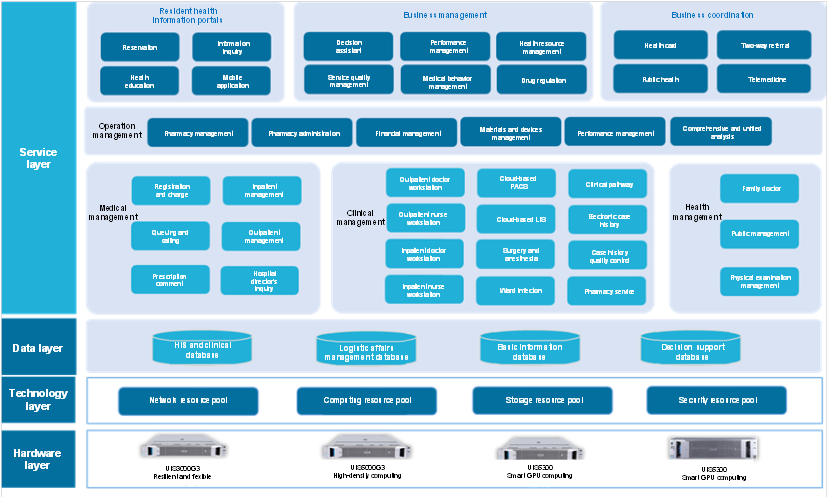Medical Hyper-Convergence
Background:
In recent years, the implementation of technologies such as virtualization and cloud computing promotes the reform of data centers in medical institutions, changing the traditional construction and management methods. The Outline of the National Healthcare Service System (2015-2020) clearly stated that new technologies such as mobile Internet, IoT, cloud computing, and wearable devices should be actively adopted to promote the development of health information and smart medical services that benefit the public.
At present, the shortcomings of the traditional data center infrastructure emerge gradually when faced with complex information systems and new businesses such as online diagnosis and treatment. Separate hardware resources, scattered management policies, and slow service deployment have affected the deployment and operating of upper layer systems to some extent, especially various new systems with microservices-based architectures. Hardware resources of traditional data centers are not flexible enough to deploy such service systems.
Pain points:
1. Separate hardware resources
The IT resources cannot be flexibly scheduled with relatively low utilization due to immobile resources and the island-style construction of traditional data centers of hospitals.
2. Slow service deployment
When deploying a new service system such as the EMR and integrated information platform, the user needs to prepare the hardware resource first, configure the network, and then install the OS, middleware, and security system, and finally install the service system. The whole process is time-consuming and labor-intensive.
3. Scattered O&M
The various providers of infrastructures such as server, storage, network, and virtualization make the configuration and management of those infrastructures much isolated and separate. The O&M personnel need to maintain each system one by one. When a fault occurs, it is time-consuming for the O&M personnel to troubleshoot it, especially for small- and medium-sized short-handed hospitals.
4. High investment costs
The hardware resources cannot maximize its value due to low resource utilization. The investment cost is increased by a separate architectural design of storage and computing, independent procurement of storage devices, and additional procurement.
Solution:

Highlights of solution:
1. Resource integration
This solution seamlessly integrates software technologies such as compute virtualization, network virtualization, storage virtualization, network security virtualization, O&M and monitoring management, and cloud service delivery on the x86 hardware platform. It uses high-speed networks with multiple sets of hyper-converged devices to accomplish horizontal and elastic scaling of modularized resources, so as to form a unified computing and storage resource pool. This helps streamline the number of servers deployed in a data center and merges IT infrastructure resources of the data center, providing a stable, efficient operation platform for various hospital service systems.
2. Fast deployment
The H3C hyper-converged architecture system enables login to cloud. To ease management and simplify operations, a UIS device can be deployed for the first time in 30 minutes and within five minutes, new nodes can be deployed and resources can be expanded. After powering on the UIS hyper-converged node, you can build the cloud computing environment and enter the UIS management platform by following three steps set out in the boot guide: set the network, register a license, and create a cluster. It is suitable for a simple delivery request from small- and medium-sized medical institutions.
3. Simple O&M
The solution integrates the six functionalities of computing, storage, networking, security, O&M monitoring, and cloud service. It enables simple O&M operations such as custom big-screen display, one-click check, system health model, drag tools on GUI to form the net topology, and homepage shortcuts, making O&M visual, data-based, automated, and intelligent, reducing the workload of O&M engineers.
4. Security assurance
This solution is equipped with the UIS-Sec security component, which is deployed in the virtual machine to realize network security functions such as routing, firewall, and load balancing. The distributed virtual firewall effectively controls the access of the east-to-west traffic, avoiding attacks and information theft between virtual machines on the same host. Technologies such as encrypted virtual machine disk (VMDK), residual data erasure, and data backup provide security protection. Apart from multiple service assurance mechanisms provided at the core layer, data layer, and service layer, this solution also provides security management and security audit, which improves the overall security of hospital data centers.
Cases:
The Sixth People's Hospital of Deyang City, Changshan County People's Hospital, Zhongwei Hospital of Traditional Chinese Medicine, Zhushan Hospital of Traditional Chinese Medicine


